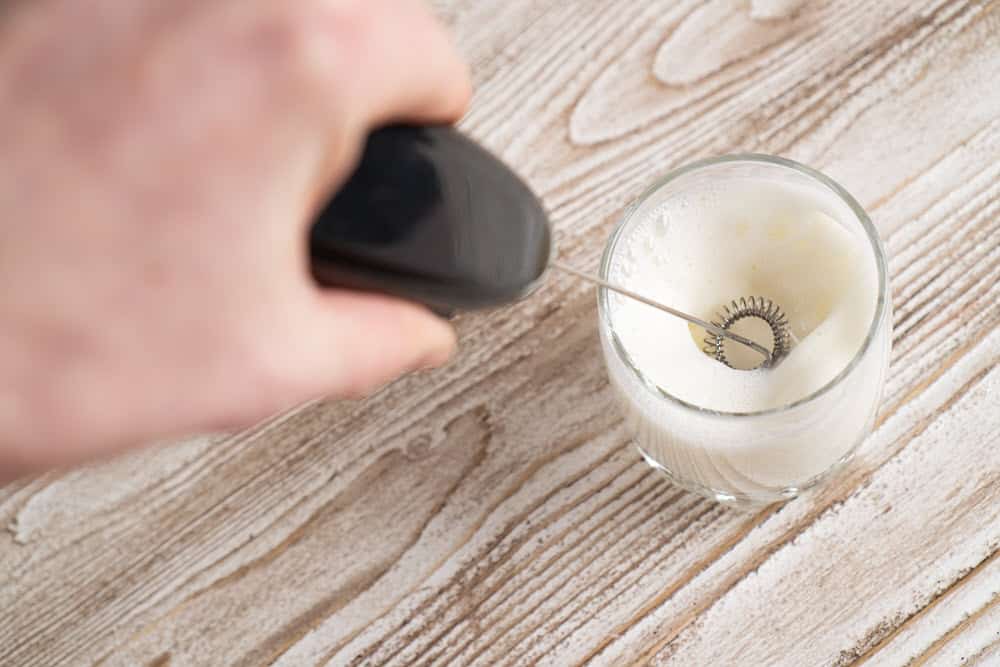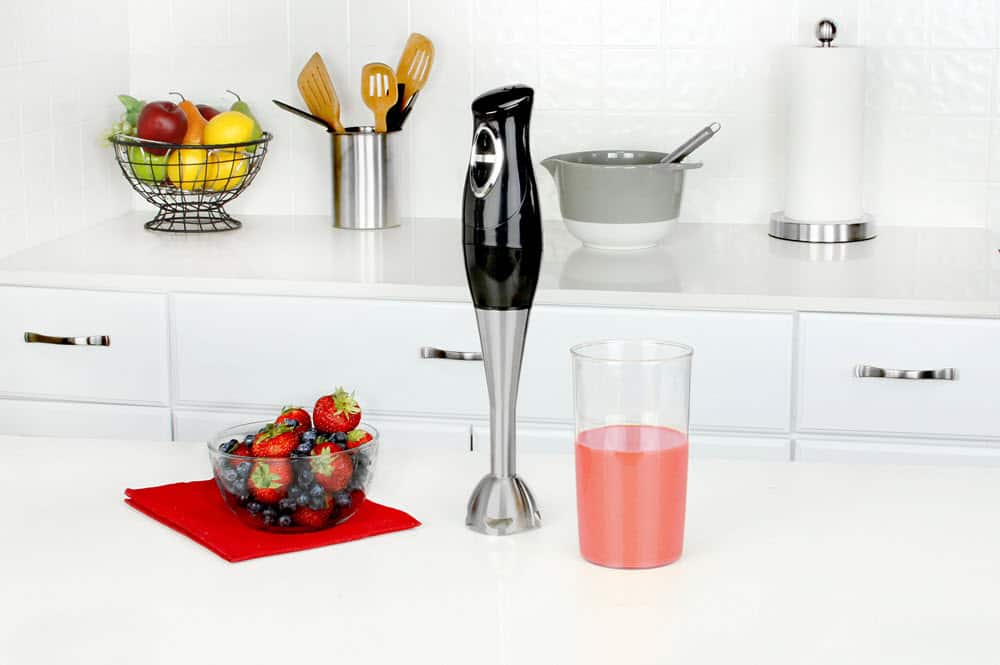The first sip of a good latte is a moment in sensory heaven: the velvet-smooth milk foam coats your tongue in a sweet prelude to the earthy punch of the coffee. It’s no wonder that, according to a 2018 report from Square, the latte is the most popular coffee shop order in America.
This indulgence does not come cheap, though: per the 2018 Square report, the average price of a latte in the U.S. was $4.16 in 2017-2018. That might not seem like much, but if you buy coffee daily, you’ll soon find yourself paying hand over fist.
The good news is that you don’t have to give up on your favorite coffee order in favor of penny-pinching. Investing in tools for making cafe-style coffee drinks at home will save you money in the long run. If you want to make lattes, you can learn to froth milk using an immersion blender or a milk frother.
Which is best for frothing milk, though? Read on to learn more about immersion blenders, milk frothers, and the difference they can make in your homemade coffee drinks.
You can put as much care into frothing your milk as you do into preparing your coffee beans. Learning about the basic science behind frothed milk will help you understand how immersion blenders and milk frothers differ in their ability to froth milk.
Frothed milk is a type of foam. In physical chemistry terms, a “foam” is a substance formed by the entrapment of gas bubbles in a liquid or solid medium. When a barista froths milk, they introduce air bubbles into the liquid via mechanical agitation or steam injection—that is, through whipping or steaming. If done correctly, the frothing process will produce a foam that has a luxuriously silky texture and remains stable for the amount of time it takes to enjoy a latte or cappuccino.
Traditionally, milk froth is made by steaming milk, preferably whole milk. As this post from the coffee industry trade publication Perfect Daily Grind explains, heating milk within an ideal temperature range improves the stability of milk foam.
Different types of milk have different ideal temperatures for frothing and steaming, as each has different quantities of fats and proteins. According to the UCLA Science & Food blog, dairy milk will create the tastiest and most stable foam at 150 degrees Fahrenheit (66 degrees Celcius), soy milk at 140 F (60 C), almond milk at 130 F (54 C), and coconut milk at 160 F (71 C).
The barista’s typical tool of choice for this process is the steam wand, which injects air into the milk while heating it to create steamed milk. Unfortunately, steam wands are usually attached to an expensive espresso machine.
You can also turn cold milk into a foamy topping for your iced coffee. Whole dairy milk and other kinds of high-fat milk will not produce a stable cold foam, however. As Science Meets Food explains, the fats in cold milk are in a partially crystallized state which makes them prone to rupturing during the foaming process, which in turn makes the foam fall faster.
What’s the difference between these kitchen tools, anyhow? To compare the milk frothing capabilities of an immersion blender vs a frother, you first need a basic understanding of how each works.
According to Nespresso, there are four types of milk frothers. Manual frothers work much like a French coffee press. Automatic frothers usually take the form of a hands-free, electricity-powered countertop carafe. Handheld frothers operate like electric whisks. Finally, barista-style steam wands attach to espresso or coffee machines.

A Milk Frother is Designed to Create Milk Foam
Manual, handheld, and automatic milk frothers aerate milk through manual agitation—that is, they incorporate air into the milk by pumping or whisking it vigorously until bubbles form.
Manual frothers are the most simplistic, and they typically land at the cheaper end of the price spectrum. They do not add heat as they work, so the user must warm the milk beforehand for hot foam.
Handheld milk frothers are also relatively inexpensive. Some handheld models warm the milk as they whisk, but most do not.
Automatic frothers simultaneously heat and aerate milk. Their automatic design means that they produce much more consistent results than handheld and manual frothers, and they are generally simple to operate.
The Bodum Electric Milk Frother
Finally, steam wand attachments, also called milk steamers, aerate and heat milk through steam injection. While steam wands may be appealing to coffee fanatics because they can produce cafe-quality foam, they require skill and experience to use. Furthermore, the fact that they require an entire espresso machine or coffee maker to operate makes them the most expensive type of milk frother.

An Immersion Blender on a Countertop
An immersion blender, also known as a stick blender or hand blender, is a hand-held alternative to a countertop blender. It takes the form of a handheld wand with a blade attachment on one end. Most immersion blenders have several speed settings, allowing the user to regulate the consistency of the blended product.
Breville’s Control Grip Immersion Blender
Some immersion blenders come with different attachments for different functions, including frothing. According to Kitchenaid, an immersion blender sans frother attachment can also froth milk on a low-speed setting, albeit less effectively.
To make hot milk froth with an immersion blender, you need to heat the milk separately.
An immersion blender or a handheld milk frother will generally take up the least space in your kitchen, as they are usually small enough to tuck into a drawer. Meanwhile, automatic milk frothers and espresso machines take up valuable counter or cabinet space.
If you don’t have much room to spare in your kitchen, you might be better off with a handheld option.
Automatic frothers produce the most consistent results for the least amount of effort. Handheld options, including immersion blenders, require time and effort to master, and human error will always produce some variance in your results.
Although its name might seem to consign it to a single destiny, a milk frother can do more than just froth milk. As the Golde Superwhisk’s copy suggests, you can use a handheld frother to mix protein shakes, matcha, energy drinks, and more. Automatic milk frothers are also great for making hot, milk-based drinks like hot chocolate.
However, immersion blenders are by far the more versatile option. A standard variable-speed immersion blender without any attachments can be used for a wide range of kitchen tasks, from pureeing soups and sauces to making smoothies; adding attachments into the mix further expands an immersion blender’s use cases.

An Immersion Blender is a Much More Heavy Duty Appliance Than a Milk Frother
If you’re a minimalist looking to streamline your kitchen setup, an immersion blender is your best bet.
An automatic frother offers the easiest method for frothing milk: just pour your milk, start the machine, and walk away. To froth milk with an immersion blender, you have to first heat the milk, then pour it into a deep container, then blend.
If you don’t have much time in the morning to luxuriate in the coffee-making process, an automatic frother can help you get out the door quickly without sacrificing the quality of your beverage.
Automatic milk frothers, steam wands, and some handheld frothers are capable of heating your milk while it aerates. Other frothing tools require you to heat the milk before frothing, which can be annoying.
Automatic frothers and steam wands also give you the most temperature control, making it easy to achieve the ideal frothing temperature for your milk of choice.
